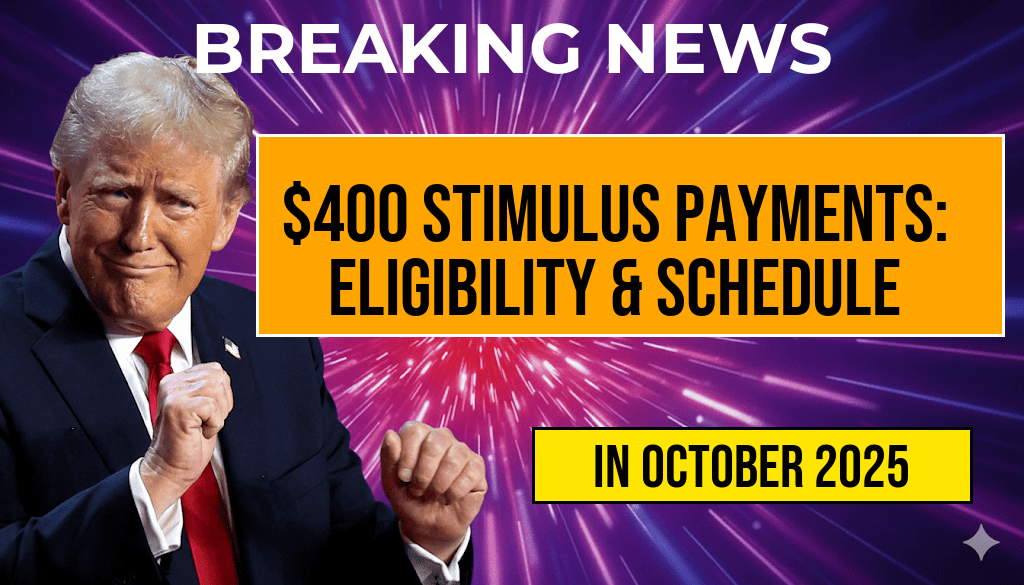A new $400 stimulus payment initiative has been announced, aimed at providing financial relief to eligible Americans amid ongoing economic challenges. This one-time payment is accessible to a broad segment of the population, with specific eligibility criteria designed to ensure targeted assistance. The federal government has released a comprehensive payment schedule, outlining when recipients can expect to receive their funds, which will be distributed via direct deposit or check. This initiative reflects ongoing efforts to support households facing rising costs and financial strain, with officials emphasizing transparency and ease of access. Eligible individuals and families interested in obtaining the payment are encouraged to review the detailed criteria and schedule below to understand their potential eligibility and the steps required to claim the funds. This article provides an in-depth overview of the eligibility requirements, application process, and complete payment timeline for the $400 stimulus payout.
Eligibility Criteria for the $400 Stimulus Payment
Who Qualifies for the Payment?
- Income Limits: Households earning up to $75,000 annually for individuals or $150,000 for married couples filing jointly are eligible to receive the full amount. Partial payments are available for those with incomes slightly above these thresholds.
- Residency Status: Applicants must be U.S. residents or citizens residing in the country as of the application date.
- Tax Filing Status: The payment is primarily targeted at individuals who filed a federal tax return for the previous year. Non-filers may need to submit a simplified form to claim their payment.
- Age Requirement: Adults aged 18 and older qualify, with certain provisions for dependents included in the calculation.
Additional Considerations
- The stimulus payment is not means-tested beyond the income thresholds outlined above.
- Recipients of other federal benefits, such as Social Security, SSDI, or veterans’ benefits, may automatically qualify without additional application steps.
- Individuals who recently changed their residence or income status should verify their eligibility through the official portal to avoid delays.
Application Process and How to Claim the Payment
Automatic Eligibility and Direct Deposit
Most eligible recipients will receive their $400 stimulus payments automatically into the bank account associated with their last federal tax return. This process is designed to minimize paperwork and expedite distribution. For those who filed taxes electronically, payments are typically processed within two to three weeks after the official payment schedule begins.
Manual Claiming Options
- Individuals who did not file taxes last year but meet eligibility criteria can submit a simplified application through the designated government portal.
- Paper checks can be requested if direct deposit is unavailable or preferred, though processing times may extend beyond electronic payments.
- Special provisions are in place for vulnerable populations, including seniors and disabled individuals, to ensure they receive their funds promptly.
Complete Payment Schedule and Distribution Timeline
| Application Submission Window | Payment Processing Dates | Expected Disbursement Dates |
|---|---|---|
| January 15 – February 15 | February 20 – March 10 | March 15 – March 20 |
| February 16 – March 15 | March 16 – April 5 | April 10 – April 15 |
| March 16 – April 15 | April 16 – May 5 | May 10 – May 15 |
Recipients are advised to monitor official communications and their bank accounts for updates. The government has also set up a dedicated portal, IRS Refunds & Payments, for tracking payment status and addressing any discrepancies.
Additional Resources and Support
For further details on eligibility or to access the application portal, individuals can visit the official IRS website. Community organizations and local government offices are also available to assist applicants with the process, especially for those unfamiliar with online applications or facing barriers to access.
As the federal government continues to evaluate additional relief measures, staying informed through reputable sources like Forbes and government updates ensures eligible Americans can take full advantage of available support programs.
Frequently Asked Questions
Question
Who is eligible to receive the $400 stimulus payment?
Answer
Eligible recipients include individuals and families who meet specific income and residency requirements as outlined by the program. Generally, tax filers with incomes below a certain threshold and residents of participating states are qualified.
Question
How can I check the status of my stimulus payment?
Answer
You can verify the status of your stimulus payment through the official government portal or the designated payment tracking system using your social security number and other required details.
Question
What is the payment schedule for the $400 stimulus?
Answer
The complete payment schedule details when recipients can expect to receive their stimulus payments. Payments are scheduled to be distributed over specific dates, which are announced by the authorities.
Question
Are joint filers eligible for the $400 stimulus payment?
Answer
Yes, joint filers who meet the eligibility criteria are entitled to receive the $400 stimulus payment. The amount may be combined based on the number of qualifying dependents and filing status.
Question
What should I do if I missed the payment or haven’t received it yet?
Answer
If you missed the payment or haven’t received it, you should contact the official government support or check the payment status online. You may also be able to update your information or request a re-issue if needed.

Leave a Reply